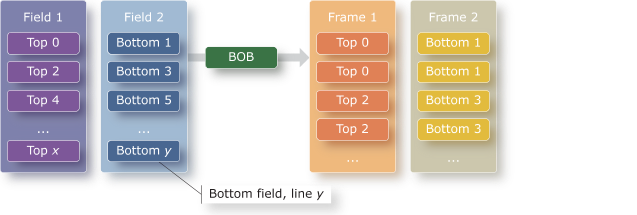The video capture API includes enumerated values that specify deinterlacing behavior.
About deinterlacing
Deinterlacing can use a variety of techniques:
- Adaptive
- Use a motion-adaptive filter. This type of deinterlacing is usually done by the hardware.
- Bob
- Take the lines of each field and double them. This technique retains the original temporal resolution.
- Bob 2
- Discard one field out of each frame to improve the video quality. The temporal resolution is halved, however.
- Weave
- Combine two consecutive fields together. The temporal resolution is halved: the resulting frame rate is half of the original field rate.
- Weave 2
- Similar to weave, but the resulting frame rate is the same as the original field rate.
 Figure 1. Deinterlacing in BOB mode
Figure 1. Deinterlacing in BOB modeEnumerated values
enum capture_deinterlace_mode {
CAPTURE_DEINTERLACE_NONE_MODE = 0,
CAPTURE_DEINTERLACE_WEAVE_MODE,
CAPTURE_DEINTERLACE_BOB_MODE,
CAPTURE_DEINTERLACE_BOB2_MODE,
CAPTURE_DEINTERLACE_WEAVE2_MODE,
CAPTURE_DEINTERLACE_MOTION_ADAPTIVE_MODE,
};
The following enumerated types are used for setting the deinterlacing mode:
- CAPTURE_DEINTERLACE_NONE_MODE
- 0
- Don't deinterlace.
- CAPTURE_DEINTERLACE_WEAVE_MODE
- Use weave deinterlacing mode.
- CAPTURE_DEINTERLACE_BOB_MODE
- Use bob deinterlacing mode.
- CAPTURE_DEINTERLACE_BOB2_MODE
- Use alternate bob deinterlacing mode.
- CAPTURE_DEINTERLACE_WEAVE2_MODE
- Use alternate weave deinterlacing mode.
- CAPTURE_DEINTERLACE_MOTION_ADAPTIVE_MODE
- Use motion adaptive deinterlacing mode.
Buffer properties
The CAPTURE_PROPERTY_*_BUFFER_ types store buffer properties:
- CAPTURE_PROPERTY_MIN_NBUFFERS
- CAPTURE_PROPERTY( 'Q', 'M', 'N', 'B' )
- Read uint32_t
- Minimum number of buffers required for a specific deinterlacing mode.
For properties used for deinterlacing frames from external sources (e.g., USB stick) see "External source properties".